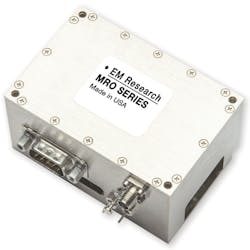Low-Noise Oscillators Replace Cavity Sources
The MRO series of microwave radio oscillators from EM Research is designed to replace cavity oscillators in analog and digital microwave radios operating from 2 to 12 GHz. Standard frequency ranges include 5300 to 5500 MHz; 5500 to 5700 MHz; 5700 to 5900 MHz; 5900 to 6100 MHz; 6100 to 6300 MHz; and 6300 to 6500 MHz. The oscillators deliver as much as +13 dBm output power with spurious levels of better than -70 dBc and frequency stability of better than ±1 ppm from -10 to +70°C. Typical phase noise at 5900 MHz is better than -95 dBc/Hz offset 10 kHz from the carrier and better than -143 dBc/Hz offset 1 MHz from the carrier. The MRO line can be tuned manually or via serial programming to within 1 kHz of a desired frequency. The oscillators include a frequency reference and nonvolatile memory for programming. They measure just 3.05 x 2.02 x 1.62 in. and are available for supplies of +5, +8, and +12 VDC (less than 300 mA current consumption).
EM Research, 1301 Corporate Blvd., Reno, NV 89502; (775) 345-2411, FAX: (775) 345-1030, e-mail: [email protected], www.emresearch.com.
